Ottawa unveils final report on MMIW inquiry consultation
No official word yet on when inquiry will start or how it will work

Remembering those who were taken: a table laden with a circle of candles surrounding a qulliq inside the Ottawa hotel meeting room where Pauktuutit held its pre-consultation meeting last February for the national inquiry on missing and murdered Indigenous women. (FILE PHOTO)
Though they’re not yet ready to say when and how they’ll conduct their national inquiry into missing and murdered Indigenous women and girls, the federal government is now ready to report what others want them to do.
Ottawa’s final report on what they heard between December 2015 and March 2016 quietly appeared May 27 on the website of the Department of Indigenous and Northern Affairs.
In it, federal bureaucrats summarize recommendations made to them during 18 inquiry design meetings held across the country with the family members of missing and murdered Indigenous women and girls, and seven other roundtables and symposiums held with a variety of stakeholders, including lawyers’ groups, Indigenous law experts, provincial and territorial leaders and Indigenous organizations.
They’ve grouped their findings within four categories:
• who should lead the inquiry, how it should be structured, and how its commissioners should be appointed;
• who should participate in the inquiry and how they should be supported;
• key issues the inquiry should look at and actions that could be taken immediately or after the inquiry starts up; and,
• cultural practices, ceremonies or health supports that should be incorporated into the design of the inquiry.
The federal government doesn’t specifically state how many of the requests they heard will be incorporated into the design of the inquiry later this year.
Here some of the key recommendations that Ottawa heard:
• the inquiry should be “independent and transparent” and led by Indigenous women, but also include men and representatives of Indigenous communities and regions;
• the inquiry should represent a diversity of views, cultures and interests and the diversity of First Nations, Métis and Inuit communities, and include representation from Indigenous organizations and family members;
• commissioners should be “healthy in spirit, body and mind” and their qualifications should include knowledge of the law, policing and the justice system;
• the participation of female survivors of violence and the families and loved ones of missing and murdered Indigenous women and girls, should be a priority throughout the inquiry and there should be no funding barriers to their participation;
• transgender and two-spirited people should be welcome to participate;
• Indigenous men and boys should be welcome to participate;
• representatives of government, justice systems and law enforcement agencies should also participate;
• the poorest and most marginalized should be included, such as incarcerated people, the homeless, sex workers, addicts and women fleeing domestic violence;
• commissioners or their representatives should travel throughout the country, including to remote northern regions, to meet with families, survivors and loved ones;
• protective measures should be used for people who feel at risk;
• monitoring of media involvement and limits on what can be broadcast;
• a national media campaign to support the inquiry; and,
• “training” media on “appropriate” coverage of the inquiry and in “a truthful portrayal of Indigenous people to prevent further reporting of stereotypes and myths.”
Inuit Tapiriit Kanatami and Tungasuvvingat Inuit teamed up on an Inuit consultation exercise that involved all four regions of Inuit Nunangat and urban Inuit in eight cities.
But ITK and TI did not take any position in their report and made no recommendations on behalf of their organizations.
Instead, they summarized what they heard and submitted the compilation to Ottawa.
“As such, the report reflects the views of the Inuit consulted, not the views of ITK or TI,” the report said.
Pauktuutit, the national Inuit women’s association, submitted a separate report based on its own consultations, conducted this past Feb. 9 to Feb. 12 in Ottawa.
In it, Pauktuutit said they want an Inuit-specific component within the inquiry, with at least two Inuit commissioners, and “parallel and equal process within the overall inquiry with appropriate financial and human resources” to deal with Inuit-specific issues.
They also called for action to better protect Inuit women who suffer violence within their families and communities.





(0) Comments